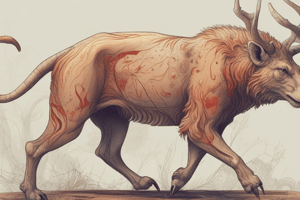Podcast
Questions and Answers
Explain the process of communication and coordination between receptors and effectors in animals.
Explain the process of communication and coordination between receptors and effectors in animals.
Animals communicate and coordinate between receptors and effectors using a fast nervous communication (nervous system) and a slower chemical/hormonal communication (endocrine system). Receptors detect stimuli in the organism's environment, and effectors such as muscles and glands respond to these stimuli.
Describe the structure and function of a neurone.
Describe the structure and function of a neurone.
A neurone is the unit of structure in the nervous system. It consists of dendrites/dendron to receive nerve impulses, a cell body containing the nucleus and organelles, an axon to carry impulses away from the cell body, and a myelin sheath to increase the speed of transmission and prevent leakage of impulses.
What are the components of the central nervous system in humans, and how are they protected?
What are the components of the central nervous system in humans, and how are they protected?
The central nervous system in humans consists of the brain, which is protected by the skull, and the spinal cord, which is protected by the back bone.
What are the two types of communication and coordination in animals, and how do they differ?
What are the two types of communication and coordination in animals, and how do they differ?
Explain the role of receptors and effectors in responding to stimuli in animals.
Explain the role of receptors and effectors in responding to stimuli in animals.
Flashcards are hidden until you start studying




